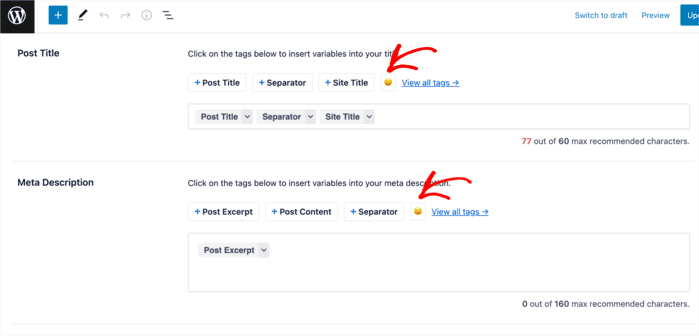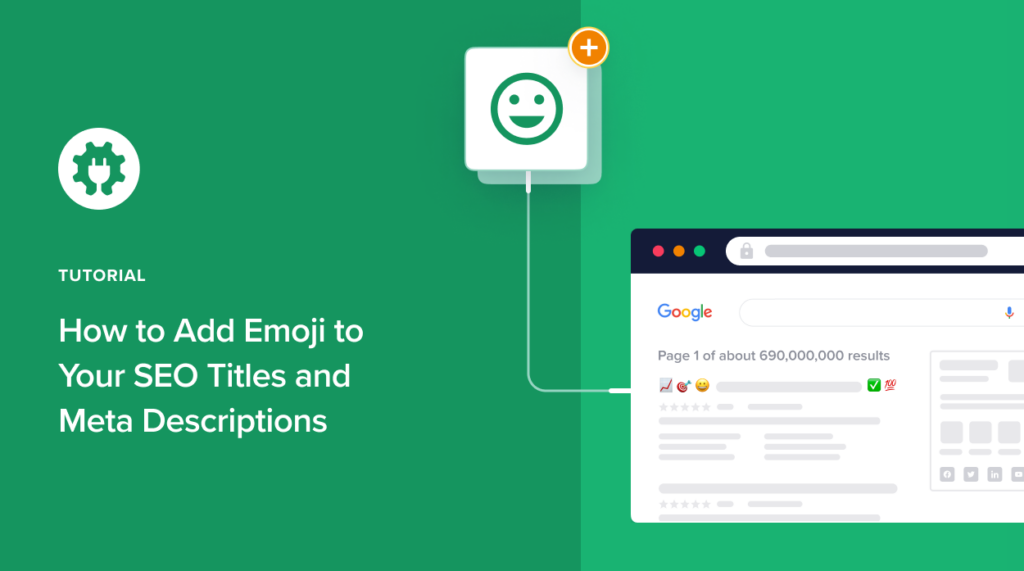Would you like to know how to add emojis to your SEO titles and meta descriptions?
Emoji are a universal language that has become synonymous with communication. And they’re fast becoming an integral part of SEO. However, you can’t add them to your content using the default WordPress editor.
In this article, we’ll show you how to add emojis to your SEO titles and meta descriptions.
In This Article
Why Add Emoji to Your SEO Titles and Meta Descriptions?
There are several reasons why you should add emojis to your SEO titles and meta descriptions. One of the most significant is that it impacts your search performance.
That’s right, emojis are fast becoming a significant element of SEO. Here are a few reasons why they’re important:
- Emoji search is on the rise: Search engines support emoji search, and more users are adopting it. With emoji SEO on the rise, you should position yourself well by including emojis in your metadata.
- Increase visibility: Emojis in your metadata increase your visibility by standing out in search snippets on SERPs.
- Boost engagement: Emojis are an excellent way of increasing engagement on SERPs. Because they are fun, users prefer to click on snippets featuring emojis. This results in a boost in CTR and more traffic to your site. They’re also a great way to boost engagement on social media.
As you can see, emojis are an essential ingredient to add to your content if you want to increase visibility, engagement, and traffic. If you want to have an edge over your competitors in search, consider adding emojis in your SEO titles and meta descriptions.
How to Add Emojis to Your SEO Titles and Meta Descriptions
Ready to create attention-grabbing search snippets by adding emojis to your SEO titles and meta descriptions?
Here’s a simple, no-code, step-by-step guide on how to do just that.
Step 1: Install and Activate All In One SEO
The first step to implementing structured data in WordPress is to install and activate the All In One SEO (AIOSEO) plugin.

AIOSEO is undoubtedly one of the best WordPress SEO plugins on the market. As a testament to that, the plugin has been downloaded over 100 million times. It’s trusted by millions of savvy marketers to help them rank their sites and drive targeted traffic.
All this is thanks to the powerful SEO features and modules found in the plugin. These include our Next-Gen Schema Generator, FAQ and Table of Contents blocks, and many more. These features are designed to help you dominate the SERPs, even if you have no technical or coding knowledge.
For step-by-step instructions on how to install AIOSEO, check out our installation guide.
AIOSEO also has an easy-to-use emoji picker that enables you to add emojis to your SEO titles and meta descriptions.
Step 2: Edit Your SEO Title and Meta Description
Editing and optimizing your metadata is super easy with AIOSEO. All you have to do is scroll down the page you’re editing till you get to the AIOSEO Settings tab. From here, you can edit the Post Title and Meta Description fields.

Fill in the relevant information in your Post Title and Meta Description fields, ensuring they’re SEO-friendly.
Step 3: Pick Your Emoji and Add It
Once you’ve filled in the relevant information, adding a relevant emoji is super easy with AIOSEO’s emoji picker.
To do that, click on the emoji icon next to the tags above each field.

Clicking on the emoji icon will open up a modal with a selection of emojis for you to choose from.

Simply click on your emoji of choice, and that’s it!
You’ve just added an emoji to your SEO title and meta description. 🎉
We hope this article has helped you know how to add emojis to your SEO titles and meta descriptions. Once you’re done, you may also want to check out our other SEO tutorials. A great example is our guide on how to add an FAQ section in WordPress. You may also want to check out our list of the best meta description tools.
If you found this article helpful, then please subscribe to our YouTube Channel. You’ll find many more helpful tutorials there. You can also follow us on X (Twitter), LinkedIn, or Facebook to stay in the loop.
Disclosure: Our content is reader-supported. This means if you click on some of our links, then we may earn a commission. We only recommend products that we believe will add value to our readers.


This is very great and an important content.
Thank you for your kind words, Loya. Glad you found the article useful.
Hopefully the emojis will be working by the time the new version is released in November.
Hi! The emojis are already working
Not for me they aren’t. That’s why the November upgrade is having to make a few adjustments so that the emojis stop disappearing.
Sorry to hear that. Would you kindly contact support our team here? Thery’ll be glad to help.
Already have done through the WordPress forums, Kato.
That’s how I know about the November update.
Its really A great achievement ..
Oh, that’s good to know I didn’t realize that using emojis was accepted by search engines. Thank you! I will definitely start using them.
They are! Glad you found the post useful, Silke.
As I know the on title presents a good SEO on YouTube.
But , Thank You so much for giving me the information that imoji also create a good SEO for web post Title and Meta Data. I’ll apply this on my next post.
This looks like something I will have to give a try.
I’ll let you know what I think of it.
Hey Victor! Would really love to here your thoughts on it once you try it.
Thanks.
Great initiative, it will surely help us
Very informative
Thanks for the tips and easy to understand for even a baby boomer
Hey Pete! Glad you found the article useful. Thanks for the comment.
Thanks to remind and give us tips of emojis I’ll add it I’ve thought its a tun off.